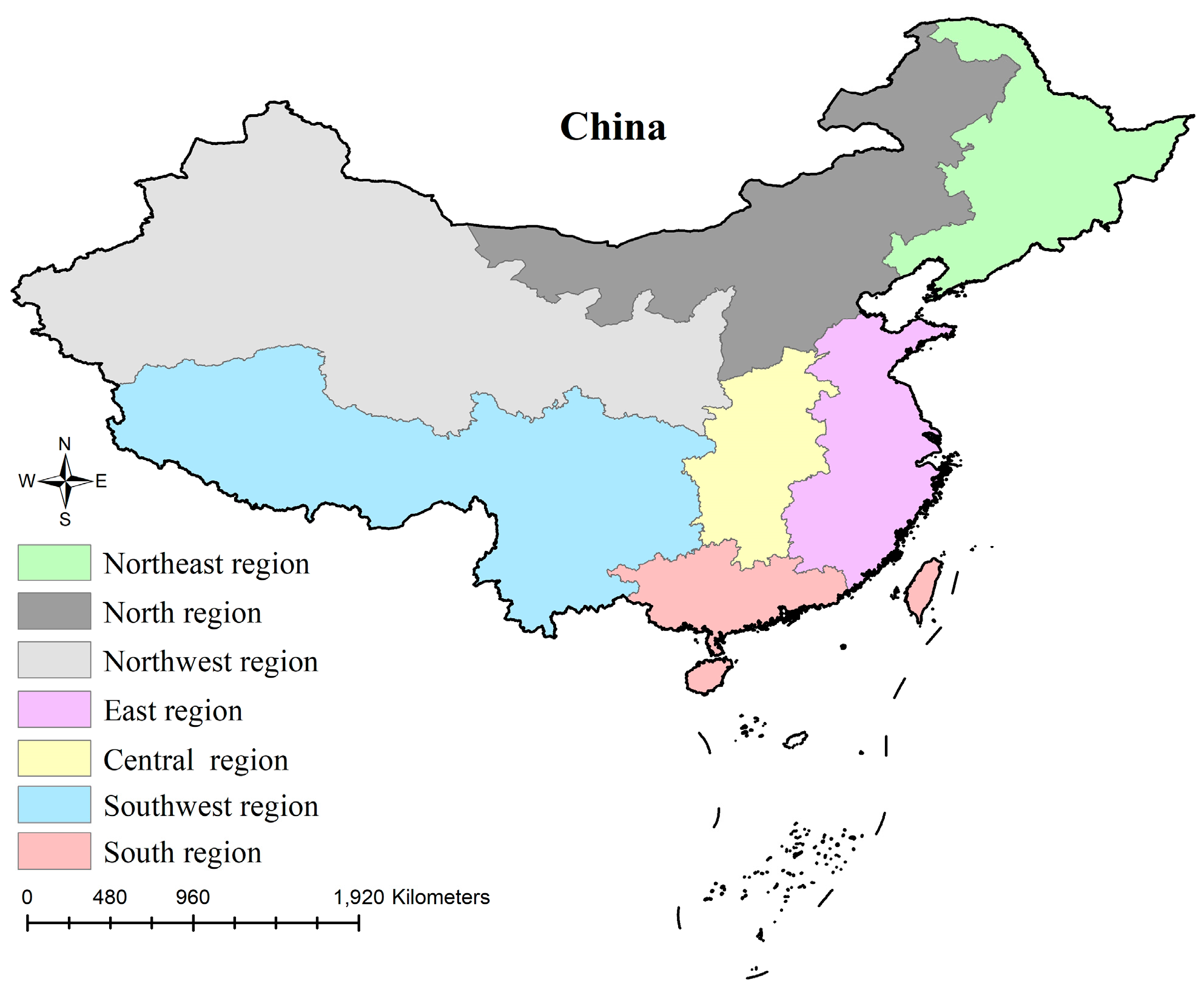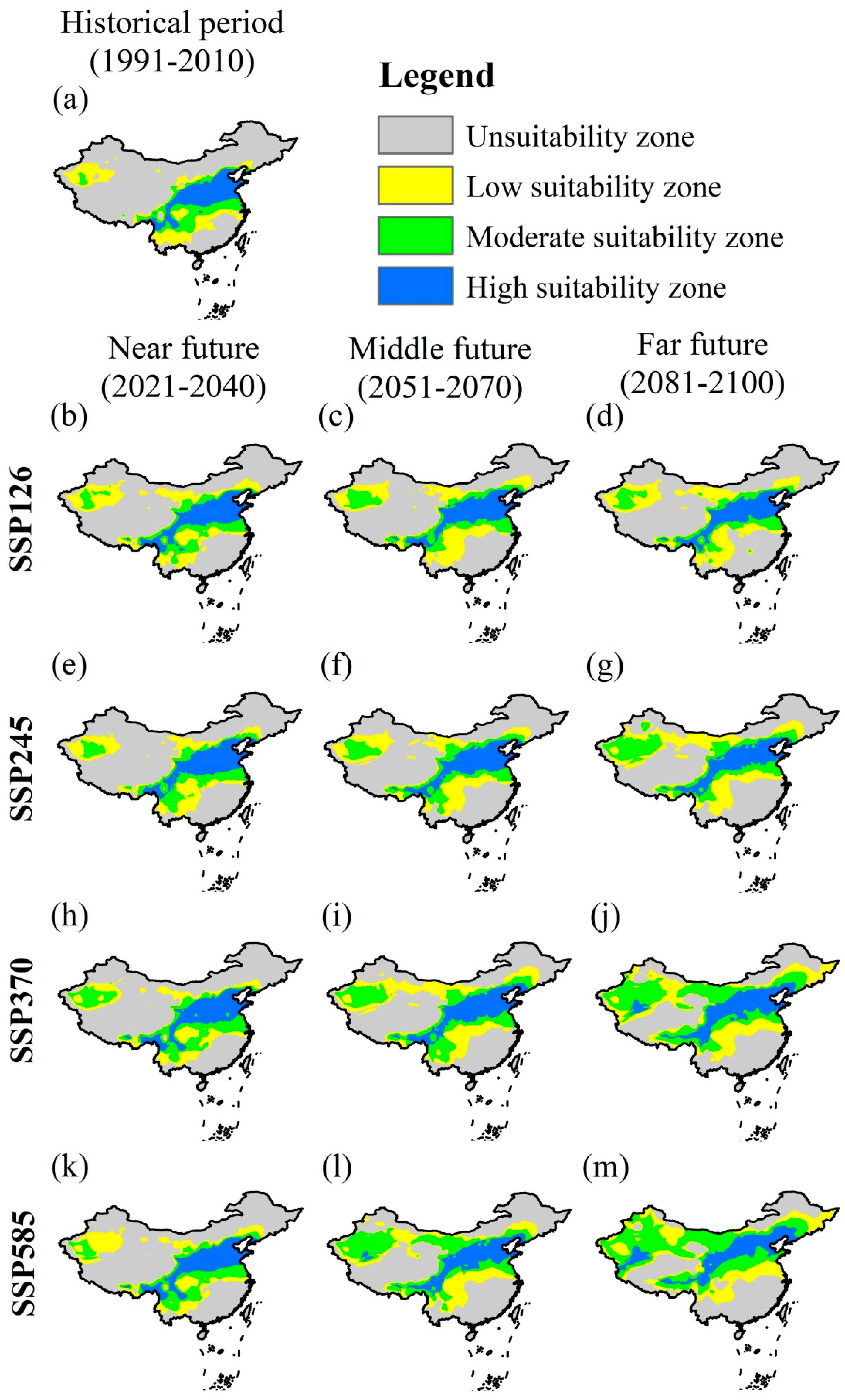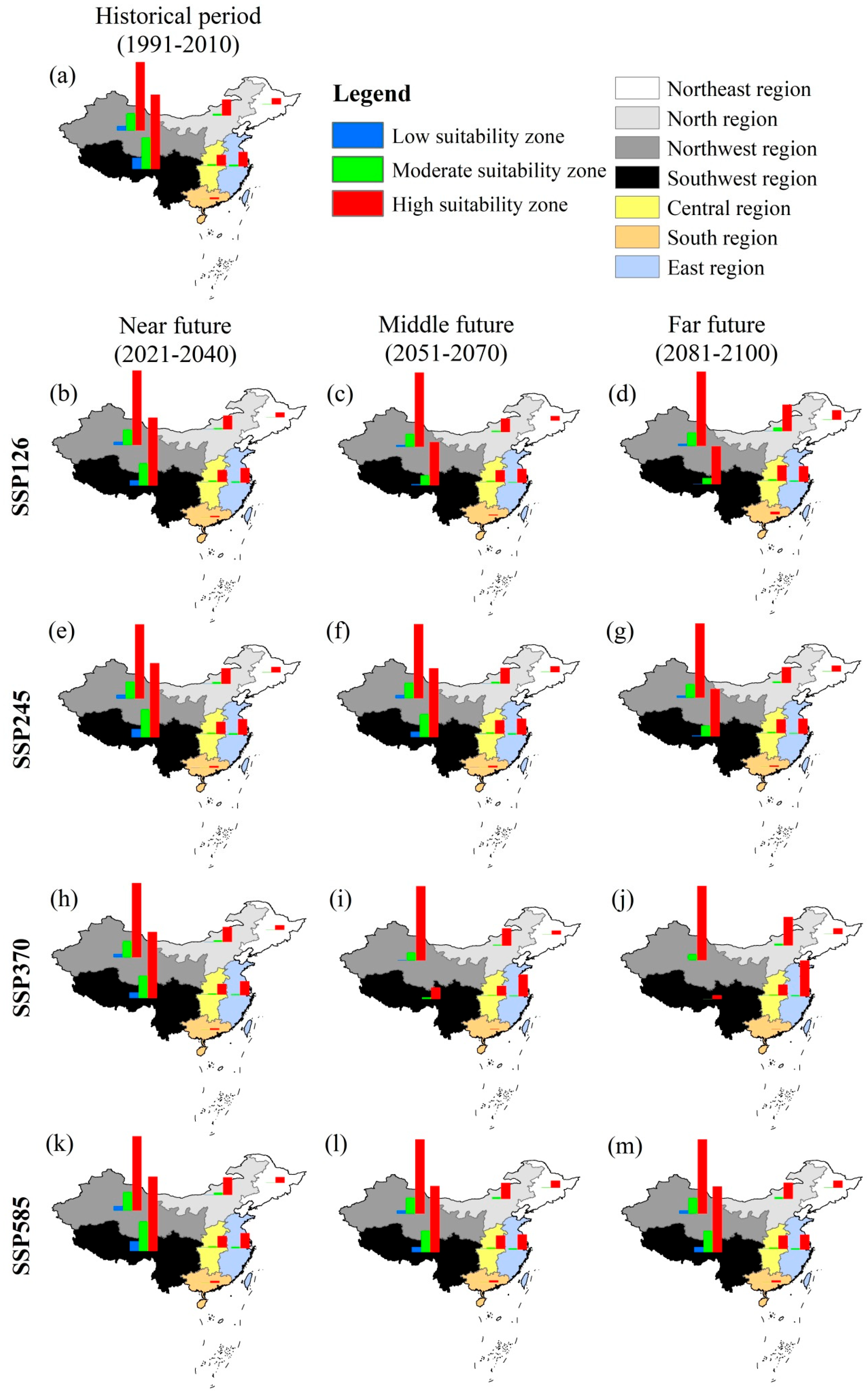Impacts of Future Climate and Farmland Changes on the Potential Cultivation Suitability of Apricot in China
Abstract
1. Introduction
2. Research Methods
2.1. Overview of the Study Area
2.2. Data Sources
2.3. Research Methods
2.3.1. Research Framework
2.3.2. Temporal Scale Division and Scenario Selection
2.3.3. Construction of the Climatic Suitability Evaluation Index System and Evaluation Method
2.3.4. Integration of Cultivated Land Constraints and Spatial Analysis
2.3.5. Comprehensive Evaluation
2.3.6. Contribution Analysis
3. Results
3.1. Changes in Climate Suitability
3.2. Changes in Farmland Suitability
3.3. Coupled Changes in Climate and Farmland Suitability
3.4. Contribution Analysis
4. Discussion
4.1. Comparison with Related Studies and Mechanism Analysis
4.2. Policy Implications
4.3. Limitations and Future Research Directions
5. Conclusions
Author Contributions
Funding
Data Availability Statement
Conflicts of Interest
References
- Mechiche-Alami, A.; Abdi, A.M. Agricultural productivity in relation to climate and cropland management in West Africa. Sci. Rep. 2020, 10, 3393. [Google Scholar] [CrossRef] [PubMed]
- Tang, Y.H.; Sun, S.K.; Lei, Y.H.; Mo, F.; Zhao, J.F.; Li, C.; Tong, J.J.; Yin, Y.L.; Wang, Y.B. Assessing the impact of climate and crop diversity on regional greenhouse gas emissions and water demand of cropland. Agric. For. Meteorol. 2024, 355, 110119. [Google Scholar] [CrossRef]
- Król-Badziak, A.; Kozyra, J.; Rozakis, S. Evaluation of climate suitability for maize production in poland under climate change. Sustainability 2024, 16, 6896. [Google Scholar] [CrossRef]
- Appelt, J.L.; Saphangthong, T.; Verburg, P.H.; van Vliet, J. Climate change impacts on the suitability of lowland and upland crop systems in Lao PDR. Agric. Syst. 2025, 226, 104316. [Google Scholar] [CrossRef]
- Guo, F.C.; Yang, Y.R.; Gao, G.Z. Climate change impact on three important species of wild fruit forest ecosystems: Assessing habitat loss and climatic niche shift. Forests 2024, 15, 1281. [Google Scholar] [CrossRef]
- Bartolini, S.; Massai, R.; Iacona, C.; Guerriero, R.; Viti, R. Forty-year investigations on apricot blooming: Evidences of climate change effects. Sci. Hortic. 2019, 244, 399–405. [Google Scholar] [CrossRef]
- Wang, R.R.; Shi, W.; Dong, P.L. Mapping dragon fruit croplands from space using remote sensing of artificial light at night. Remote Sens. 2020, 12, 4139. [Google Scholar] [CrossRef]
- Pechan, P.M.; Bohle, H.; Obster, F. Reducing vulnerability of fruit orchards to climate change. Agric. Syst. 2023, 210, 103713. [Google Scholar] [CrossRef]
- DeMartino, G.; Massantini, R.; Botondi, R.; Mencarell, F. Temperature affects impact injury on apricot fruit. Postharvest Biol. Technol. 2002, 25, 145–149. [Google Scholar] [CrossRef]
- Iovane, M.; Izzo, L.G.; Cirillo, A.; Romano, L.E.; Di Vaio, C.; Aronne, G. Flowering and pollen resilience to high temperature of apricot cultivars. Sci. Hortic. 2022, 304, 111261. [Google Scholar] [CrossRef]
- Durmaz, S.; Ağır, H.B. Assessing the effect of El Niño–Southern Oscillation on apricot yield in Malatya Province, Türkiye. Appl. Fruit Sci. 2024, 66, 2231–2238. [Google Scholar] [CrossRef]
- Teixeira, C.M.; Krüger, A.P.; Nava, D.E.; Garcia, F.R.M. Potential global distribution of the south American cucurbit fruit fly Anastrepha grandis (Diptera: Tephritidae). Crop Prot. 2021, 145, 105647. [Google Scholar] [CrossRef]
- Park, S.; Lim, C.H.; Kim, S.J.; Isaev, E.; Choi, S.E.; Lee, S.D.; Lee, W.K. Assessing climate change impact on cropland suitability in Kyrgyzstan: Where are potential high-quality cropland and the way to the future. Agronomy 2021, 11, 1490. [Google Scholar] [CrossRef]
- Vacek, Z.; Bílek, L.; Remeš, J.; Vacek, S.; Cukor, J.; Gallo, J.; Simunek, V.; Bulusek, D.; Brichta, J.; Vacek, O.; et al. Afforestation suitability and production potential of five tree species on abandoned farmland in response to climate change, Czech Republic. Trees 2022, 36, 1369–1385. [Google Scholar] [CrossRef]
- Feng, J.R.; Xi, W.P.; Li, W.H.; Liu, H.N.; Liu, X.F.; Lu, X.Y. Volatile characterization of major apricot cultivars of southern Xinjiang region of China. J. Am. Soc. Hortic. Sci. 2015, 140, 466–471. [Google Scholar] [CrossRef]
- Yang, J.Y.; Huo, Z.G.; Wang, P.J.; Wu, D.R.; Ma, Y.P.; Yao, S.R.; Dong, H.Y. Process-based indicators for timely identification of apricot frost disaster on the warm temperate zone, China. Theor. Appl. Climatol. 2021, 146, 1143–1155. [Google Scholar] [CrossRef]
- Sun, R.Z.; Tong, G.J.; Zhang, Q.; Xu, L.J.; Sang, Z.H.; Li, Y.H. A study on the suitable areas for growing apricot kernels in China based on the MaxEnt mode. Sustainability 2023, 15, 9635. [Google Scholar] [CrossRef]
- Han, H.Q.; Yang, J.Q.; Liu, Y.; Zhang, Y.J.; Wang, J.W. Effect of the Grain for Green Project on freshwater ecosystem services under drought stress. J. Mt. Sci. 2022, 19, 974–986. [Google Scholar] [CrossRef]
- Qiao, X.; Chen, X.W.; Lei, J.J.; Sai, L.H.; Xue, L.H. Apricot-based agroforestry system in Southern Xinjiang Province of China: Influence on yield and quality of intercropping wheat. Agrofor. Syst. 2020, 94, 477–485. [Google Scholar] [CrossRef]
- Xin, Q.; Zhou, X.Q.; Jiang, W.B.; Zhang, M.; Sun, J.; Cui, K.B.; Liu, Y.; Jiao, W.X.; Zhao, H.D.; Liu, B.D. Effects of reactive oxygen levels on chilling injury and storability in 21 apricot varieties from different production areas in China. Foods 2023, 12, 2378. [Google Scholar] [CrossRef]
- Wang, Z.; Kang, M.; Liu, H.B.; Gao, J.; Zhang, Z.D.; Li, Y.Y.; Wu, R.L.; Pang, X.M. High-level genetic diversity and complex population structure of Siberian apricot (Prunus sibirica L.) in China as revealed by nuclear SSR markers. PLoS ONE 2014, 9, e87381. [Google Scholar] [CrossRef]
- Assunção, R.M.; Souza, L.S.; Camargo, N.F.; Aguiar, A.J.C.; Sujii, E.R.; Pires, C.S.S.; Togni, P.H.B. Low abundance of regular pollinators and indirect competitive effects of dominant small bees negatively affect passion fruit pollination in smallholder croplands. Neotrop. Entomol. 2025, 54, 32. [Google Scholar] [CrossRef]
- Aparecido, L.E.D.; Torsoni, G.B.; Lorencone, J.A.; Lorencone, P.A.; de Lima, R.F.; Rolim, G.D.; Saqui, D.; de Oliveira, G.G., Jr. Future climate suitability of Hemileia vastatrix in arabica coffee under CMIP6 scenarios. J. Sci. Food Agric. 2025, 105, 394–421. [Google Scholar] [CrossRef]
- Liao, W.; Liu, X.; Xu, X.; Chen, G.; Liang, X.; Zhang, H.; Li, X. Projections of land use changes under the plant functional type classification in different SSP-RCP scenarios in China. Sci. Bull. 2020, 65, 1935–1947. [Google Scholar] [CrossRef] [PubMed]
- Wu, J.Y.; Luo, J.A.; Zhang, H.; Qin, S.; Yu, M.J. Projections of land use change and habitat quality assessment by coupling climate change and development patterns. Sci. Total Environ. 2022, 847, 157491. [Google Scholar] [CrossRef] [PubMed]
- Zhang, S.Q.; Yang, P.; Xia, J.; Wang, W.Y.; Cai, W.; Chen, N.C.; Hu, S.; Luo, X.G.; Li, J.; Zhan, C.S. Land use/land cover prediction and analysis of the middle reaches of the Yangtze River under different scenarios. Sci. Total Environ. 2022, 833, 155238. [Google Scholar] [CrossRef] [PubMed]
- Huang, P.; Xie, H.; Yang, Y.T.; Hu, X.H.; Liu, C.L.; Xu, Y.; Song, C.H.; Dai, C.S.; Khan, S.; Cui, Y.L.; et al. Spatiotemporal variation in rice water requirements and area in the cold rice cultivation region of China: Past and future. Agric. Water Manag. 2024, 298, 108858. [Google Scholar] [CrossRef]
- Yang, J.Y.; Zhang, L.; Huo, Z.G.; Wang, P.J.; Wu, D.R.; Ma, Y.P. Disaster process–based spatiotemporal characteristics of apricot frost in the warm temperate zone (WTZ), China. Int. J. Biometeorol. 2023, 67, 1733–1744. [Google Scholar] [CrossRef]
- Zhu, J.; Wang, P.; Jiang, H.; Tang, J.; Youhao, E.; Yang, J.; Huo, Z. Climatic suitability regionalization of fruit apricot in Chinese mainland based on the MaxEnt model. Chin. J. Ecol. 2023, 42, 91–98. [Google Scholar]
- Albuja-Illescas, L.M.; Eraso Terán, O.H.; Arias-Muñoz, P.; Basantes-Vizcaíno, T.-F.; Jiménez-Lao, R.; Lao, M.T. Multi-criteria analysis of a potential expansion of protected agriculture in Imbabura, Ecuador. Agronomy 2025, 15, 1518. [Google Scholar] [CrossRef]
- Yang, J.Y.; Dong, H.Y.; Huo, Z.G.; Wang, P.J.; Yao, S.R.; Wu, D.R.; Ma, Y.P. Threshold-based characteristics of apricot frost exposure at young fruit in the warm temperate zone, China. Int. J. Climatol. 2022, 42, 1460–1471. [Google Scholar] [CrossRef]
- Fadl, M.E.; Abuzaid, A.S.; AbdelRahman, M.A.E.; Biswas, A. Evaluation of desertification severity in El-Farafra Oasis, western desert of Egypt: Application of modified MEDALUS approach using wind erosion index and factor analysis. Land 2022, 11, 54. [Google Scholar] [CrossRef]
- Du, T.; Li, C.; Wang, Z. Spatial differentiation and influencing mechanisms of farmland transfer rents in mountainous areas: Evidence from Chongqing and its surrounding areas. Land 2023, 12, 699. [Google Scholar] [CrossRef]
- Zhang, Y.; Lin, J.; Huang, Y.; Yuan, H.; Feng, G.; Zhang, P. Spatial analysis and coordinated layout optimization of farmland-orchard mismatch using spatial decision modeling. Trans. Chin. Soc. Agric. Eng. 2024, 40, 330–338. [Google Scholar]
- Farooque, A.A.; Zaman, Q.U.; Chang, Y.K.; Corscadden, K.W.; Schumann, A.W.; Chattha, H.S.; Madani, A.; Abbas, A. Influence of soil properties and topographic features on wild blueberry fruit yield. Appl. Eng. Agric. 2016, 32, 379–388. [Google Scholar] [CrossRef]
- Xiao, X.; Liu, M.; He, Q.; Hu, Q.; Gao, X.; Lun, F. Expansion characteristics and planting suitability assessment of Orchard based on linear spectral mixed decomposition. Trans. Chin. Soc. Agric. Mach. 2023, 54, 234–245. [Google Scholar]
- Chen, X.; Chen, F.; Cui, F.; Lei, W. Spatial heterogeneity of sustainable land use in the Guangdong–Hong Kong–Macao greater bay area in the context of the carbon cycle: GIS-based big data analysis. Sustainability 2023, 15, 1715. [Google Scholar] [CrossRef]
- Shaukat, R.S.; Khan, M.M.; Shahid, M.; Shoaib, M.; Khan, T.A.; Aslam, M.A. Quantitative contribution of climate change and land use change to runoff in Tarbela catchment, Pakistan. Pol. J. Environ. Stud. 2020, 29, 3295–3304. [Google Scholar] [CrossRef]
- Agila, F.A.R.; Kiraz, A. Climate change and agricultural risks: Perception of farmers from a socio-economic sustainability perspective. Sustainability 2025, 17, 7285. [Google Scholar] [CrossRef]
- Meza, F.; Darbyshire, R.; Farrell, A.; Lakso, A.; Lawson, J.; Meinke, H.; Nelson, G.; Stockle, C. Assessing temperature-based adaptation limits to climate change of temperate perennial fruit crops. Glob. Change Biol. 2023, 29, 2557–2571. [Google Scholar] [CrossRef]
- Caspersen, L.; Schiffers, K.; Picornell, A.; Egea, J.A.; Delgado, A.; El Yaacoubi, A.; Benmoussa, H.; Rodrigo, J.; Fadón, E.; Ben Mimoun, M.; et al. Contrasting responses to climate change—Predicting bloom of major temperate fruit tree species in the Mediterranean region and Central Europe. Agric. For. Meteorol. 2025, 375, 110859. [Google Scholar] [CrossRef]
- Sun, W.X.; Gao, Y.X.; Ren, R.X.; Wang, J.Y.; Wang, L.; Liu, X.J.; Liu, Y.T.; Jiu, S.T.; Wang, S.P.; Zhang, C.X. Climatic suitability projection for deciduous fruit tree cultivation in main producing regions of northern China under climate warming. Int. J. Biometeorol. 2022, 66, 1997–2008. [Google Scholar] [CrossRef]
- Li, F.; Qin, Z.X.; Liu, X.L.; Chen, Z.H.; Wei, X.L.; Zhang, Q.M.; Lei, M. Grain production space reconstruction and land system function tradeoffs in China. Geogr. Sustain. 2021, 2, 22–30. [Google Scholar] [CrossRef]
- Pan, J.; Xue, X.; Huang, C.H.; You, Q.A.; Guo, P.L.; Yang, R.Q.; Da, F.; Duan, Z.W.; Peng, F. Effect of salinization on soil properties and mechanisms beneficial to microorganisms in salinized soil remediation-a review. Res. Cold Arid Reg. 2024, 16, 121–128. [Google Scholar] [CrossRef]
- Fernandez, E.; Mojahid, H.; Fadon, E.; Rodrigo, J.; Ruiz, D.; Egea, J.A.; Ben Mimoun, M.; Kodad, O.; El Yaacoubi, A.; Ghrab, M.; et al. Climate change impacts on winter chill in Mediterranean temperate fruit orchards. Reg. Environ. Change 2023, 23, 7. [Google Scholar] [CrossRef]
- Yourek, M.; Liu, M.; Scarpare, F.V.; Rajagopalan, K.; Malek, K.; Boll, J.; Huang, M.; Chen, M.; Adam, J.C. Downscaling global land-use/cover change scenarios for regional analysis of food, energy, and water subsystems. Front. Environ. Sci. 2023, 11, 1055771. [Google Scholar] [CrossRef]
- Vetharaniam, I.; Timar, L.; Stanley, C.J.; Müller, K.; van den Dijssel, C.; Clothier, B. Modelling climate change impacts on location suitability and spatial footprint of apple and kiwifruit. Land 2022, 11, 1639. [Google Scholar] [CrossRef]
- Pan, Y.; Lin, Y.; Yang, R. Agricultural production space suitability in China: Spatial pattern, influencing factors and optimization strategies. Int. J. Environ. Res. Public Health 2022, 19, 13812. [Google Scholar] [CrossRef]
- Song, M.; Qing, S.; Wu, Q.; Zhu, H. Climate change in China and its effects on the sustainable efficiency of agricultural land use. Land 2025, 14, 1260. [Google Scholar] [CrossRef]
- Chen, B.; Zhao, G.; Tian, Q.; Yao, L.J.; Srivastava, A.K.; Chen, S.; Yao, N.; He, L.; Yu, Q. Spatially-explicitly predicting suitability of three apple diseases in China: A comparative analysis of five species distribution models. J. Phytopathol. 2025, 173, e70123. [Google Scholar] [CrossRef]
- Evin, G.; Ribes, A.; Corre, L. Assessing CMIP6 uncertainties at global warming levels. Clim. Dyn. 2024, 62, 8057–8072. [Google Scholar] [CrossRef]
- Lv, T.; Peng, S.Z.; Liu, B.; Liu, Y.N.; Ding, Y.X. Planting suitability of China’s main grain crops under future climate change. Field Crops Res. 2023, 302, 109112. [Google Scholar] [CrossRef]
- Mombo, V.G.; Duvallet, M.; Schaeffer, M.; Baarsch, F. Have crops already reached peak suitability: Assessing global climatic suitability decreases for crop cultivation. Environ. Res. Lett. 2025, 20, 034009. [Google Scholar] [CrossRef]
- Leng, G.Y. Global impact assessment of internal climate variability on maize yield under climate change. Earths Future 2025, 13, e2024EF004888. [Google Scholar] [CrossRef]







| Indicator | Weight | Classification Criteria (Assigned Values) | |||
|---|---|---|---|---|---|
| Highly Suitable (3) | Moderately Suitable (2) | Lowly Suitable (1) | Unsuitable (0) | ||
| Annual precipitation (mm) | 0.32 | 440 ≤ R ≤ 990 | 360 ≤ R < 440 or 990 < R ≤ 1300 | 60 ≤ R < 360 or 1300 < R ≤ 1450 | R < 60 or R > 1450 |
| Spring frost probability (%) | 0.26 | 0 ≤ R ≤ 7 | 7 < R ≤ 15 | 15 < R ≤ 26 | R > 26 |
| Mean temperature of the coldest month (°C) | 0.23 | −5.2 ≤ R ≤ 2.9 | −8.9 ≤ R < −5.2 or 2.9 < R ≤ 8.4 | −13.2 ≤ R < −8.9 or 8.4 < R ≤ 13 | R < −13.2 or R > 13 |
| Days with mean temperature 0–7 °C (Dec–Mar) | 0.11 | R ≥ 45 | 38 ≤ R < 45 | 30 ≤ R < 38 | R < 30 |
| Accumulated temperature ≥10 °C (°C·d) | 0.08 | R ≥ 4200 | 3200 ≤ R < 4200 | 2800 ≤ R < 3200 | R < 2800 |
| Slope (°) | Suitability Level | Description |
|---|---|---|
| 6–10 | Highly suitable | Moderate relief, good drainage, high soil permeability, non-overlapping with basic farmland; conducive to root growth and heat accumulation of apricot trees |
| 10–15 | Moderately suitable | Steeper terrain but can be improved through terracing and vegetation stabilization measures |
| 15–25 | Low suitable | Steep slopes, low mechanization, high soil erosion risk |
| <6 or >25 | Unsuitable | The former mainly refers to plains, key grain-producing areas that should be protected; the latter are steep and erosion-prone areas unsuitable for cultivation |
| Regions | Historical Period | Future Periods Under Different Scenarios | ||||||||
|---|---|---|---|---|---|---|---|---|---|---|
| SSP126 | SSP245 | SSP370 | SSP585 | |||||||
| CC | FC | CC | FC | CC | FC | CC | FC | CC | FC | |
| Northeast China | 68.4 | 31.6 | 70.2 | 29.8 | 72.1 | 27.9 | 74.5 | 25.5 | 76.3 | 23.7 |
| North China | 63.5 | 36.5 | 64.1 | 35.9 | 65.8 | 34.2 | 68.7 | 31.3 | 70.2 | 29.8 |
| East China | 60.4 | 39.6 | 61.3 | 38.7 | 63.5 | 36.5 | 64.8 | 35.2 | 65.1 | 34.9 |
| Northwest China | 69.8 | 30.2 | 72.4 | 27.6 | 74.1 | 25.9 | 76.8 | 23.2 | 78.4 | 21.6 |
| Central China | 61.9 | 38.1 | 63.7 | 36.3 | 65.2 | 34.8 | 67.5 | 32.5 | 69.1 | 30.9 |
| Southwest China | 57.8 | 42.2 | 59.4 | 40.6 | 61.2 | 38.8 | 63.8 | 36.2 | 65.4 | 34.6 |
| Southern China | 54.2 | 45.8 | 55.6 | 44.4 | 57.1 | 42.9 | 59.3 | 40.7 | 60.5 | 39.5 |
| Nationwide | 62.3 | 37.7 | 63.8 | 36.2 | 65.6 | 34.4 | 68.0 | 32.0 | 69.9 | 30.1 |
Disclaimer/Publisher’s Note: The statements, opinions and data contained in all publications are solely those of the individual author(s) and contributor(s) and not of MDPI and/or the editor(s). MDPI and/or the editor(s) disclaim responsibility for any injury to people or property resulting from any ideas, methods, instructions or products referred to in the content. |
© 2025 by the authors. Licensee MDPI, Basel, Switzerland. This article is an open access article distributed under the terms and conditions of the Creative Commons Attribution (CC BY) license (https://creativecommons.org/licenses/by/4.0/).
Share and Cite
Han, H.; Song, H.; Wang, K.; Jian, Y. Impacts of Future Climate and Farmland Changes on the Potential Cultivation Suitability of Apricot in China. Horticulturae 2025, 11, 1409. https://doi.org/10.3390/horticulturae11111409
Han H, Song H, Wang K, Jian Y. Impacts of Future Climate and Farmland Changes on the Potential Cultivation Suitability of Apricot in China. Horticulturae. 2025; 11(11):1409. https://doi.org/10.3390/horticulturae11111409
Chicago/Turabian StyleHan, Huiqing, Huili Song, Kai Wang, and Yuanju Jian. 2025. "Impacts of Future Climate and Farmland Changes on the Potential Cultivation Suitability of Apricot in China" Horticulturae 11, no. 11: 1409. https://doi.org/10.3390/horticulturae11111409
APA StyleHan, H., Song, H., Wang, K., & Jian, Y. (2025). Impacts of Future Climate and Farmland Changes on the Potential Cultivation Suitability of Apricot in China. Horticulturae, 11(11), 1409. https://doi.org/10.3390/horticulturae11111409






